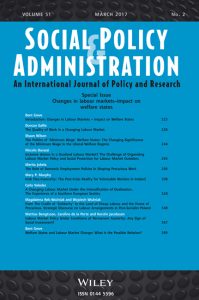Technology and precariousness: the employment downgrading of Europe’s middle class
Since the advent of the first industrial revolution, the growing automation of production processes has been accompanied by concerns (or hopes) regarding the displacement of human labour. Although significant increases in productivity occurred over the last century, we can argue – evidence at hand – that no mass displacement has occurred following the diffusion of computing and robotic technologies. The latter (especially ICTs), together with globalization, are typically cited as the main engines driving advanced capitalist economies from manufacturing-based toward knowledge-based growth models, profoundly reshaping the labour market (Diessner et al., 2025; Hall, 2022). Nonetheless, empirical research provides limited support for the notion of ‘technological unemployment’, rather showing gradual intergenerational phase-out with fewer new entries than retirees in mid-skill occupations, traditionally performing repetitive tasks (e.g., office clerks, skilled industrial workers, bank tellers, etc.) (Cortes, 2015; Kurer & Gallego, 2019).
However, research abounds with evidence of technology-led reorganization of labour processes and activities, ranging from task standardization to algorithmic surveillance. Recent contributions also indicate that automation is associated with limited career advancement and earnings opportunities for workers employed in routine occupations, as well as reallocation to less valued tasks (Autor, 2013; Parolin, 2020). A key puzzle in the study of automation lies in the growing resentment among these low-middle-class workers, which has been linked to rising support for radical right parties across the Western world (Kurer and Palier, 2019).
The lack of consolidated evidence on automation’s impact on employment conditions motivates a new study published in the International Journal of Social Welfare, that shows robust correlations between task routineness and precarious employment. In the paper, I argue that the task-based framework largely used to analyse automation’s occupational impact can be fruitfully employed to investigate labour-market segmentation. The article shows that mid-skill workers have experienced downgrading earnings and employment instability, drawing them closer to the low-skill service ‘precariat’ (e.g., cashiers, waiters, janitors, etc.). More specifically, by means of a regression analysis based on data from the European Social Survey (2002-2018), I show that – following their shrinking prominence in the production systems – routine workers in Western Europe have faced significant and stable income losses, along with a higher likelihood of fixed-term employment. Moreover, labour-market institutions are found to significantly mitigate the risks of employment flexibilization, while the Great Recession (2007-2009) appears to have triggered a lasting impoverishment of mid-skill workers across the whole continent. Overall, descriptive evidence from Eurostat (1992-2020) shows a stark divergence between the rising labour earnings of high-skill professions, coupled with open-ended and full-time contracts, and the stagnating wages of both mid- and low-skill occupations, as well as higher probabilities of being employed with an atypical contract.

The paper reconciles skill-based and task-based approaches investigating labour-market segmentation, proposing a ‘recalibrated’ dualization of the European workforce: traditional low-skill ‘outsiders’ are now joined by workers with intermediate levels of education, while high labour standards are increasingly reserved to high-skill professionals. Surprisingly, labour-market institutions have shown limited effectiveness in shielding routine workers from employment downgrading, particularly during economic downturns, when cost-competitiveness motivations might have reinforced labour-unfriendly usages of technologies.
This scenario contributes to our understanding of the radical right success across Europe, suggesting a linkage between the status concerns of the declining middle class and structural changes in the labour market. Although technological change has not led to mass unemployment among semi-skilled blue- and white-collar workers, the remarkable decline in employment quality plausibly explains their growing sense of deprivation, sharply contrasting with the generous social and labour protection granted them during the industrial era. In conclusion, the article suggests not to dismiss concerns for technology’s negative impacts on labour market, rather shifting the focus from employment share to quality.
References
Autor, D. H. (2013). The “task approach” to labor markets: an overview. Journal for Labour Market Research, 46(3), 185–199.
Cortes, G. M. (2015). Where Have the Middle-Wage Workers Gone? A Study of Polarization Using Panel Data. Journal of Labor Economics, 34(1), 63–105,
Diessner, S., Durazzi, N., Filetti, F., Hope, D., Kleider, H., & Tonelli, S. (2025). The transition to the knowledge economy in advanced capitalist democracies: A new index for comparative research. Socio-Economic Review.
Hall, P. A. (2022). The Shifting Relationship between Post-War Capitalism and Democracy (The Government and Opposition /Leonard Schapiro Lecture, 2021). Government and Opposition, 57(1), 1–30.
Kurer, T. & Gallego, A. (2019). Distributional consequences of technological change: Worker-level evidence. Research and Politics, 6(1), 1–9.
Kurer, T. & Palier, B. (2019). Shrinking and shouting: the political revolt of the declining middle in times of employment polarization. Research and Politics, 6(1).
Parolin, Z. (2020). Automation, Occupational Earnings Trends, and the Moderating Role of Organized Labor. Social Forces, 99(3), 921–945.






1520-6688/asset/Capture.jpg?v=1&s=b5076c49a7d1c5f1b9cf0dd9cd292394a3be81cc)
1468-0491/asset/society_affiliation_image.gif?v=1&s=859caf337f44d9bf73120debe8a7ad67751a0209)